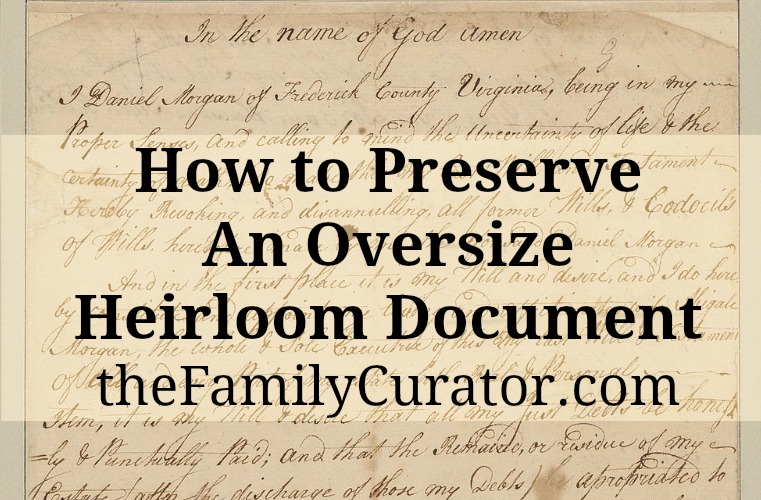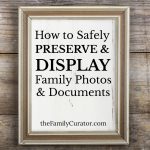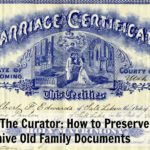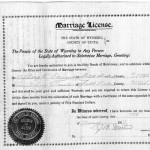 Is there an economical solution for preserving one oversize document?
Is there an economical solution for preserving one oversize document?
Last week I talked with a woman who wanted to preserve one large document. It was too large to slip inside an archival sheet protector and, reasonably enough, she didn’t want to buy a large archival box for only one item. She didn’t need a home archive, she just needed a home for her treasure.
Sometimes, it seems like it’s harder to preserve one item than a dozen, especially when archival supplies are sold packaged in quantities of 10 or more. I have a large family collection with documents of all sizes. I’d go broke buying specialty storage for each separate size. Instead, I buy archival materials locally and create my own simple DIY archival folders.
Do-It-Yourself Archival Solution
You need a sheet of heavy-weight, white, archival board, about the weight of good card stock. Archival board is often available at art supply and framing stores. Look for acid-free, lignin-free board used by artists or framers. I purchase single sheets at Blick Art Supply (available nationally) and Swains (Glendale, California).
The art store staff might be able to score and fold the sheet for you. Otherwise, when you get the board home, place it on a clean table and measure to find the center. Use a yardstick and bone folder (or a firm-tipped tool) to score the paper for easier folding.
Fold the board in half, and place your clean, unfolded document inside. Label the folder on the outside. Store the folder on a shelf in a closet or on the bottom of a large drawer. It’s fine to put something on top of your folder; Don Williams, Smithsonian Senior Conservator, recommends stacking paper tightly to reduce oxygen thus slowing deterioration.
You can also store two or three documents together in one folder with a piece of acid-free tissue placed between each sheet (available from your art store).
Keep the folder away from heat, moisture, pests, and light and store it where temperature and humidity are relatively consistent. A closet or drawer are good storage choices inside your home.
Upgrade Option
By placing your document inside an acid-free folder you’ve created the first and most important layer of protection against rough handling and environmental damage. Add another layer of protection to your document at any time by placing the folder inside a large archival acid-free box.
I purchase archival folders and boxes from manufacturers who supply university libraries, museums and archives, primarily Hollinger Metal Edge and Gaylord Archival. Hollinger invented the gray metal-edged “Holllinger Box” seen in archives worldwide and Gaylord has supplied school libraries for decades. Both companies offer small-quantity orders which are good for family historians.
Other archival suppliers may offer similar storage boxes; but be careful to purchase true archival-quality containers. Look for acid-free, lignin free boxes. You may have to order in quantities of three or more, so find a friend or someone in your genealogical society who will share an order with you.
For more ideas on locating your home archive and preserving different kinds of family treasures, check out my book How to Archive Family Keepsakes: Learn How to Preserve Family Photos, Memorabilia and Genealogy Records .






Hello. I have a 16″ x 20″ Sepia photo of my grandparent’s wedding from 1920. The photo is made of some sort of heavy cardboard. The surface of the photo has some stains that I’d like to clean off. Can you recommend a product and/or technique for cleaning the surface of this precious photo? Thank you.
Hi Bob,
I wish I could send you a magic wand to clean off those old stains. Unfortunately, most often staining is due to water damage, acid migration, mildew, mold, or general deterioration and it’s work best left to a professional photo conservator. I suggest finding help through your local historical society or at the American Institute for Conservation of Historic and Artistic Works website http://www.conservation-us.org.
There is good news, however! Many times, it’s more feasible to turn to digital restoration and print a new copy of the old photo. Since your photo is too large for most flatbed scanners, you may need to digitize it with a DSLR camera or take it to a camera shop or photo scanning service for scanning at high-resolution in TIFF or high quality JPG format. Many services offer photo restoration as well. This is the best way to “restore” an damaged old photo with minimal risk.
Good luck! ~ Denise
Often, local printers who still receive printing dies, will be glad to give you archival boxes for free, to avoid storing them. I’ve picked up a few and use the acid-free tissue paper between pages. I’ve been able to store entire newspapers this way.
Great idea, LC. Thanks so much for sharing this idea. Look on the side of the box to be sure they are marked acid-free (they should be, if the paper was acid-free). If you need folders to further divide the contents, create your own folders with large sheets of acid-free heavy-weight paper folded in half.